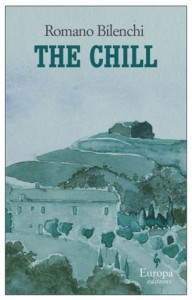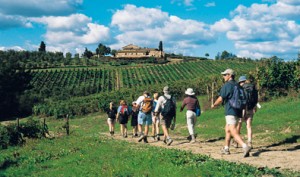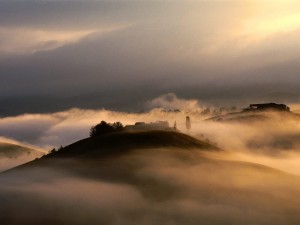Note: Romano Bilenchi (1909 – 1989), author of over ten novels, was winner of Italy’s prestigious Viareggio Prize in 1972. This book has just this month been made available in English for the first time.
“A subtle chill unexpectedly came over me, whenever my imagination placed before me images of the people with whom my existence was entwined: sometimes I became uneasy even at the thought of my classmates, the boys I saw every day. I feared the slightest change…”
The las t novella written by acclaimed Italian author Romano Bilenchi before his death in 1989, The Chill, written in 1982, is a coming-of-age story so universal that it could just as easily have been written in 1902 or 2002. Set in the mid-1920s, in the hill towns between Siena and Florence, the novella recreates the story of an unnamed narrator dealing with the pangs of adolescence so skillfully that the reader can easily associate it with the author’s own childhood—and though the setting is dramatically different from that of J. D. Sallinger’s Catcher in the Rye, or L. P. Hartley’s The Go-Between, or any of the other coming-of-age novels one might recall, the issues are similar in many respects.
t novella written by acclaimed Italian author Romano Bilenchi before his death in 1989, The Chill, written in 1982, is a coming-of-age story so universal that it could just as easily have been written in 1902 or 2002. Set in the mid-1920s, in the hill towns between Siena and Florence, the novella recreates the story of an unnamed narrator dealing with the pangs of adolescence so skillfully that the reader can easily associate it with the author’s own childhood—and though the setting is dramatically different from that of J. D. Sallinger’s Catcher in the Rye, or L. P. Hartley’s The Go-Between, or any of the other coming-of-age novels one might recall, the issues are similar in many respects.
The emphasis throughout is of an adolescent’s awareness of the death of family members and the loss that represents, the changes which accompany death, an individual’s relationship with the past and history, the importance of memory, and the extent to which other people’s perception of reality can color forever the reality itself for the participants in those same events. Using fewer words than most such novels, Bilenchi’s The Chill changes the emphasis of most coming-of-age novels from the inner lives of those novels’ speakers to the external worlds in which th ey live—replete with malice, ignorance, and even vengeance, which affect every aspect of the lives of the teenagers as they are growing up. Whether one is “good” or “bad,” in the universal sense, becomes more an issue of whether one has been good or bad as perceived by local consensus, and in this respect the novella is more socially conscious than the typical coming-of-age novel, which is usually focused on the main character’s own responses to external issues.
ey live—replete with malice, ignorance, and even vengeance, which affect every aspect of the lives of the teenagers as they are growing up. Whether one is “good” or “bad,” in the universal sense, becomes more an issue of whether one has been good or bad as perceived by local consensus, and in this respect the novella is more socially conscious than the typical coming-of-age novel, which is usually focused on the main character’s own responses to external issues.
The main character here, unnamed, is an innocent sixteen-year-old when he accompanies his math professor in high school, and his all-boys’ class, on a once-a-week hike into the nearby Tuscan hills between Siena and Florence. His grandfather has been ill recently, and has been showing signs of senility, compulsively imagining his family’s participation as ancient Longobard (Lombard) warriors in the area’s history. While the grandfather is trying to assert some long-time association with history to guarantee his own memory, however, the speaker is just trying to get by as a teenager who loves his grandfat her but must deal with the real, existing, world and the interrelationships which govern it. On the speaker’s return from his hike, he discovers that his beloved grandfather has passed away, a traumatic experience which dramatically affects his life.
her but must deal with the real, existing, world and the interrelationships which govern it. On the speaker’s return from his hike, he discovers that his beloved grandfather has passed away, a traumatic experience which dramatically affects his life.
The speaker, who experiences a “chill” at the changes that have occurred in his life, soon discovers even more dramatically that friendships are fickle, and that no amount of “preparation” can substitute for life as it is actually lived. Friendships are temporary, no matter now seriously and “sacrosanct” the speaker himself may regard them. Harassment, even by “friends,” occurs with regularity toward those who are seen as “different,” and the mob mentality rules. Often lonely and isolated, the speaker, who is also dealing with his growing sexuality and the frustrations that involves, is not sure how to deal with his need to be accepted and the conflicts he feels about his role in a wider world. His family does not help him to deal with these problems.
he feels about his role in a wider world. His family does not help him to deal with these problems.
With its focus on family history, death, friendship, love, betrayal, and revenge, this novella deals with the most important of life’s issues, and while it does so within the context of the speaker’s own life, it is so universal and so significant in its conclusions that it is as relevant today as it was when it was written. Ultimately, the speaker’s discovery that “it wasn’t possible to live among other people if all of a sudden they could attack one another with such ferocity” leaves open the issue of what a teenager is to do to survive these attacks, and rings with the recognition of truth. A coming-of-age classic.
Notes: The author’s photo appears on http://www.e-toscana.com
REI has hiking tours from Florence to Siena, similar to those of the main character here: http://www.rei.com
The photo of morning mist over hills near Siena shows how little has changed between the present, when this photo was taken, and the 1920s when the main character was seeing the same sights. http://citypictures.org
